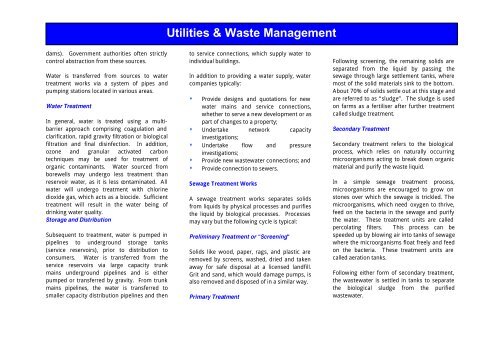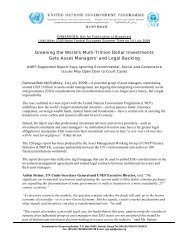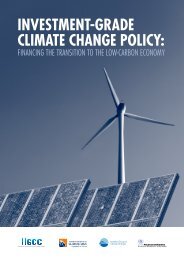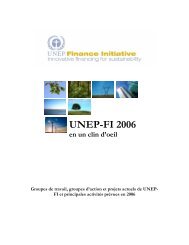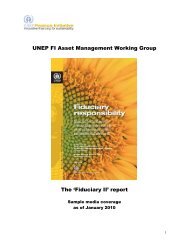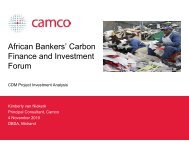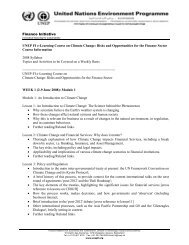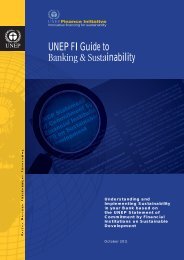Utilities & Waste Management - UNEP Finance Initiative
Utilities & Waste Management - UNEP Finance Initiative
Utilities & Waste Management - UNEP Finance Initiative
You also want an ePaper? Increase the reach of your titles
YUMPU automatically turns print PDFs into web optimized ePapers that Google loves.
<strong>Utilities</strong> & <strong>Waste</strong> <strong>Management</strong><br />
dams). Government authorities often strictly<br />
control abstraction from these sources.<br />
Water is transferred from sources to water<br />
treatment works via a system of pipes and<br />
pumping stations located in various areas.<br />
Water Treatment<br />
In general, water is treated using a multibarrier<br />
approach comprising coagulation and<br />
clarification, rapid gravity filtration or biological<br />
filtration and final disinfection. In addition,<br />
ozone and granular activated carbon<br />
techniques may be used for treatment of<br />
organic contaminants. Water sourced from<br />
borewells may undergo less treatment than<br />
reservoir water, as it is less contaminated. All<br />
water will undergo treatment with chlorine<br />
dioxide gas, which acts as a biocide. Sufficient<br />
treatment will result in the water being of<br />
drinking water quality.<br />
Storage and Distribution<br />
Subsequent to treatment, water is pumped in<br />
pipelines to underground storage tanks<br />
(service reservoirs), prior to distribution to<br />
consumers. Water is transferred from the<br />
service reservoirs via large capacity trunk<br />
mains underground pipelines and is either<br />
pumped or transferred by gravity. From trunk<br />
mains pipelines, the water is transferred to<br />
smaller capacity distribution pipelines and then<br />
to service connections, which supply water to<br />
individual buildings.<br />
In addition to providing a water supply, water<br />
companies typically:<br />
s Provide designs and quotations for new<br />
water mains and service connections,<br />
whether to serve a new development or as<br />
part of changes to a property;<br />
s Undertake network capacity<br />
investigations;<br />
s Undertake flow and pressure<br />
s<br />
s<br />
investigations;<br />
Provide new wastewater connections; and<br />
Provide connection to sewers.<br />
Sewage Treatment Works<br />
A sewage treatment works separates solids<br />
from liquids by physical processes and purifies<br />
the liquid by biological processes. Processes<br />
may vary but the following cycle is typical:<br />
Preliminary Treatment or “Screening”<br />
Solids like wood, paper, rags, and plastic are<br />
removed by screens, washed, dried and taken<br />
away for safe disposal at a licensed landfill.<br />
Grit and sand, which would damage pumps, is<br />
also removed and disposed of in a similar way.<br />
Primary Treatment<br />
Following screening, the remaining solids are<br />
separated from the liquid by passing the<br />
sewage through large settlement tanks, where<br />
most of the solid materials sink to the bottom.<br />
About 70% of solids settle out at this stage and<br />
are referred to as “sludge”. The sludge is used<br />
on farms as a fertiliser after further treatment<br />
called sludge treatment.<br />
Secondary Treatment<br />
Secondary treatment refers to the biological<br />
process, which relies on naturally occurring<br />
microorganisms acting to break down organic<br />
material and purify the waste liquid.<br />
In a simple sewage treatment process,<br />
microorganisms are encouraged to grow on<br />
stones over which the sewage is trickled. The<br />
microorganisms, which need oxygen to thrive,<br />
feed on the bacteria in the sewage and purify<br />
the water. These treatment units are called<br />
percolating filters. This process can be<br />
speeded up by blowing air into tanks of sewage<br />
where the microorganisms float freely and feed<br />
on the bacteria. These treatment units are<br />
called aeration tanks.<br />
Following either form of secondary treatment,<br />
the wastewater is settled in tanks to separate<br />
the biological sludge from the purified<br />
wastewater.


